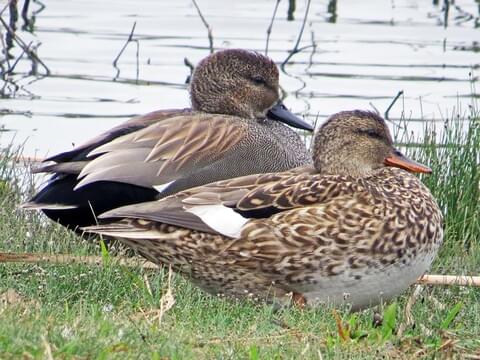Gadwall

Scientific Name:
Mareca strepera
Alternative Names:
Grey Duck, Common Gadwall
Measurements:
| Feature | Male | Female |
|---|---|---|
| Length | 47–58 cm (19–23 in) | 47–58 cm (19–23 in) |
| Weight | Around 990 g (35 oz) | Around 850 g (30 oz) |
| Wingspan | 78–85 cm (31–33 in) | 78–85 cm (31–33 in) |
Status
Classified as Least Concern by the IUCN. Populations are stable or increasing in many regions.
Identification
A medium-sized dabbling duck. Males have finely patterned grey bodies, black tail coverts, and a white speculum that shows clearly in flight. Females are brown and mottled, similar to a female mallard but smaller, with an orange-edged bill and a white belly. Both sexes have a white speculum and soft brown heads.
Voice
Generally quiet. Females make a higher-pitched version of the mallard’s quack. Males produce short grunts like mep and soft whistles, especially during courtship.
Diet
Feeds mainly on aquatic plants, seeds, grasses, pondweed, and algae. Also takes small aquatic insects and snails. It dabbles on the water surface but can also dive more than most dabbling ducks.
Distribution
Breeds across northern and central Europe, Asia, and central North America. In North America, found from Canada down through the Dakotas and Great Lakes to parts of California and Kansas. Winters further south, reaching Central America and coastal regions.
Habitat
Prefers shallow freshwater wetlands, lakes, marshes with reeds, wet grasslands, and slow-moving rivers. Often seen in open water with nearby vegetation.
Breeding
Nests are built on the ground, usually hidden in tall grass or reeds, sometimes far from water. Females lay 7–12 eggs. Incubation lasts about 24–27 days. The ducklings leave the nest after 1–2 days and are cared for by the female.
Wintering
Migratory. Northern birds travel south to warmer areas in winter, occupying wetlands in southern North America, parts of Europe, and Asia.
Conservation
Not threatened and populations are increasing globally. However, habitat loss from wetland drainage and hunting pressure can affect local numbers. Conservation programs in North America help maintain sustainable populations through habitat protection and responsible hunting.
